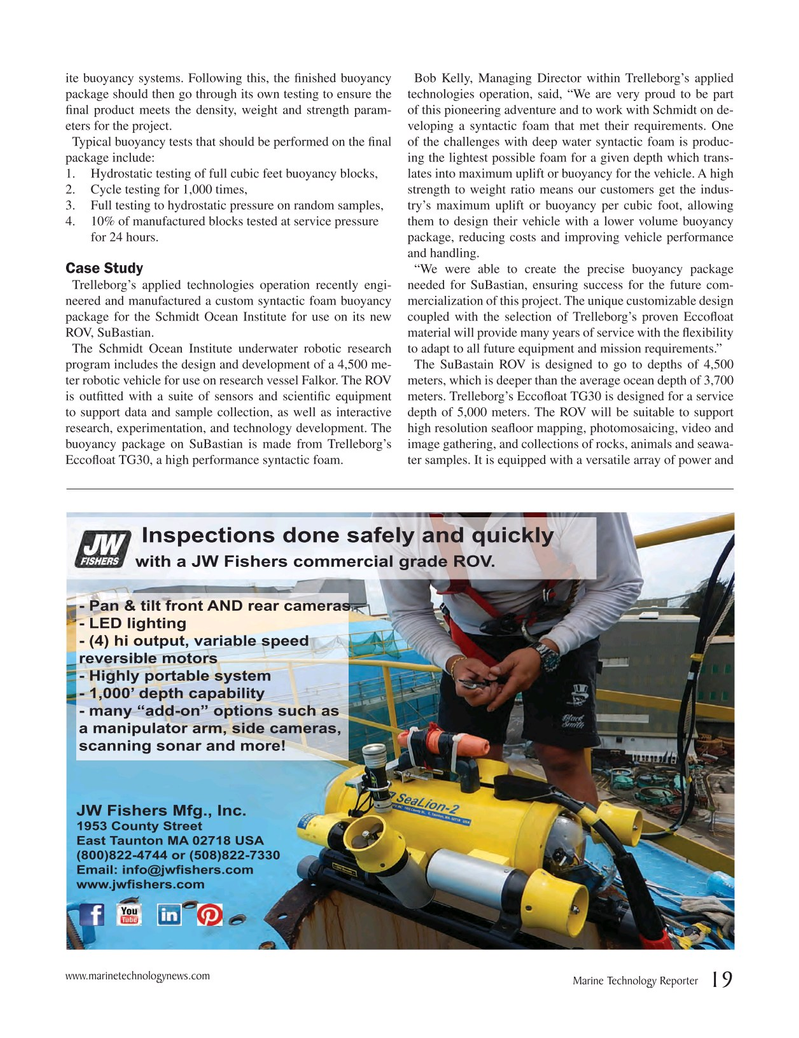
Page 19: of Marine Technology Magazine (May 2017)
Underwater Defence
Read this page in Pdf, Flash or Html5 edition of May 2017 Marine Technology Magazine
ite buoyancy systems. Following this, the ? nished buoyancy Bob Kelly, Managing Director within Trelleborg’s applied package should then go through its own testing to ensure the technologies operation, said, “We are very proud to be part ? nal product meets the density, weight and strength param- of this pioneering adventure and to work with Schmidt on de- eters for the project. veloping a syntactic foam that met their requirements. One
Typical buoyancy tests that should be performed on the ? nal of the challenges with deep water syntactic foam is produc- package include: ing the lightest possible foam for a given depth which trans- 1. Hydrostatic testing of full cubic feet buoyancy blocks, lates into maximum uplift or buoyancy for the vehicle. A high 2. Cycle testing for 1,000 times, strength to weight ratio means our customers get the indus- 3. Full testing to hydrostatic pressure on random samples, try’s maximum uplift or buoyancy per cubic foot, allowing 4. 10% of manufactured blocks tested at service pressure them to design their vehicle with a lower volume buoyancy for 24 hours. package, reducing costs and improving vehicle performance and handling.
Case Study “We were able to create the precise buoyancy package
Trelleborg’s applied technologies operation recently engi- needed for SuBastian, ensuring success for the future com- neered and manufactured a custom syntactic foam buoyancy mercialization of this project. The unique customizable design package for the Schmidt Ocean Institute for use on its new coupled with the selection of Trelleborg’s proven Ecco? oat
ROV, SuBastian. material will provide many years of service with the ? exibility
The Schmidt Ocean Institute underwater robotic research to adapt to all future equipment and mission requirements.” program includes the design and development of a 4,500 me- The SuBastain ROV is designed to go to depths of 4,500 ter robotic vehicle for use on research vessel Falkor. The ROV meters, which is deeper than the average ocean depth of 3,700 is out? tted with a suite of sensors and scienti? c equipment meters. Trelleborg’s Ecco? oat TG30 is designed for a service to support data and sample collection, as well as interactive depth of 5,000 meters. The ROV will be suitable to support research, experimentation, and technology development. The high resolution sea? oor mapping, photomosaicing, video and buoyancy package on SuBastian is made from Trelleborg’s image gathering, and collections of rocks, animals and seawa-
Ecco? oat TG30, a high performance syntactic foam. ter samples. It is equipped with a versatile array of power and
Inspections done safely and quickly with a JW Fishers commercial grade ROV.
- Pan & tilt front AND rear cameras - LED lighting - (4) hi output, variable speed reversible motors - Highly portable system - 1,000’ depth capability - many “add-on” options such as a manipulator arm, side cameras, scanning sonar and more!
JW Fishers Mfg., Inc.
1953 County Street
East Taunton MA 02718 USA (800)822-4744 or (508)822-7330 (PDLOLQIR#MZ¿VKHUVFRP
ZZZMZ¿VKHUVFRP www.marinetechnologynews.com
Marine Technology Reporter 19
MTR #4 (18-33).indd 19 MTR #4 (18-33).indd 19 4/26/2017 12:22:42 PM4/26/2017 12:22:42 PM

 18
18

 20
20
